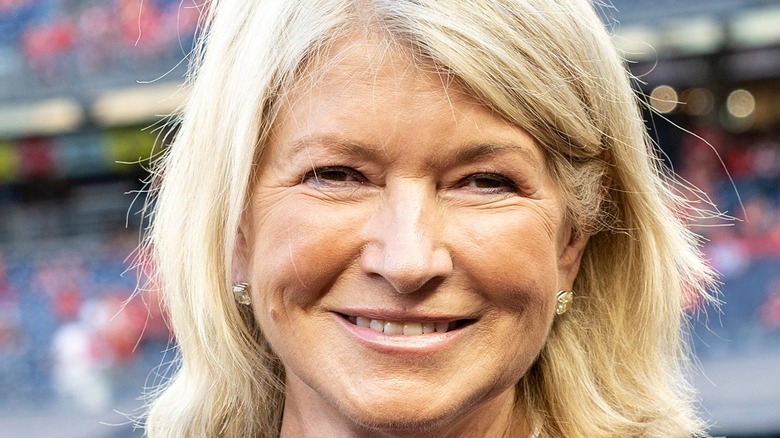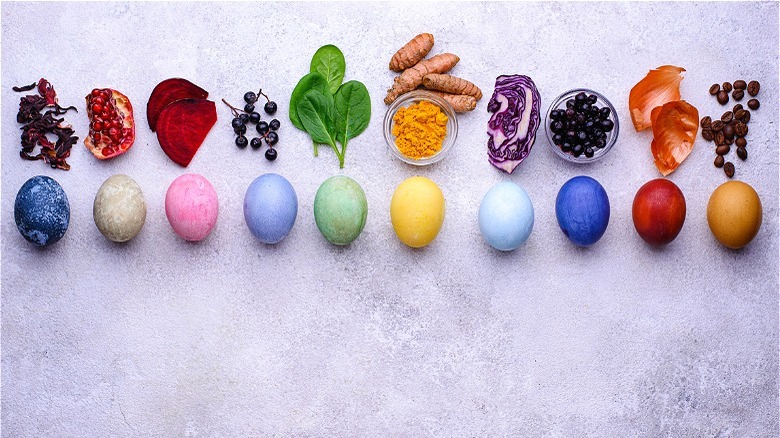How Martha Stewart Adds Pops Of Color To Her Recipes Without The Use Of Food Dye
Who can deny the alluring colors that line glass jars in candy stores and bakery cases across America? One 2015 study claims color is what sets the stage for all people's food experiences and can even alter how individuals perceive flavors. The FDA claims color additives are primarily used to create whimsical foods but also to denote distinctions between food flavors. Most importantly the FDA states artificial food dyes are generally safe to eat.
However, there have been numerous studies and claims against color additives throughout the years, specifically in regard to their adverse effect on children. One 2004 study was even able to prove a notable difference in children's hyperactivity when 3-year-old participants underwent withdrawal from artificial dyes and benzoate preservatives. Healthline also points out potential links between artificial dyes to allergies and cancer, yet more research needs to be conducted to prove the validity of these claims.
While the jury is still out on artificial food coloring, Martha Stewart is one of many popular chefs to share alternatives when you still want some additional color on your plate. According to PBS, Martha Stewart has cultivated a name for herself over the years as a know-all guru of sorts when it comes to decorating, lifestyle, and food choices. If you're looking to add more color to your recipes, you may want to give her natural method a try.
Martha Stewart's natural way to add color to your food
If you're familiar with Martha Stewart, you are already privy to her aspirations of leading a balanced lifestyle. Just one click on the "healthy recipes" tab on her website provides you with a slew of options for adding a little more thoughtfulness to what you're eating. In 2013, Stewart even released a book titled "Living the Good Life" which entails small ways you can take extra care of yourself and others. Yet when it comes to staying healthy and consuming sweets Stewart told USA Today, "I'm not fanatic about it at all. Everyone is going to eat a piece of cake now and then."
Speaking of cake, the health-conscious chef has a history of using freeze-dried fruit in her desserts to add a delightful pop of color. In 2018 Stewart shared this method on Instagram by posting dreamy pastel butter cookies tinted with freeze-dried mango, raspberries, and blueberries. Then in spring 2022, Stewart shared another photo on social media of a strawberry bundt cake which included an inner layer of batter dyed with freeze-dried strawberries.
Berries aren't the only ingredient used for dying foods either. With just a few simple steps you can make your own natural food dyes right in your own kitchen.
How to make your own natural food dyes at home
While Martha Stewart is known for using freeze-dried berries in cakes, cookies, and even strawberry butter which is noted on her website, the popular chef and media titan also offers other options for natural food coloring. Stewart notes well-known brands that have developed their own natural food dyes over the years including McCormick, India Tree, and Suncore Foods. Yet, if you want to try making your own, all you need are some colorful whole foods.
Before you beautify all your favorite desserts with natural food dyes, you may want to know the foods that work best for dying. If you're simply looking to add color to your cake frosting, pulverized freeze-dried fruit works best since the consistency mirrors powdered sugar. Yet, PureWow claims you can achieve liquid dyes for other foods by either juicing or cooking down all kinds of vegetables such as carrots, spinach, and red bell peppers, or foods naturally rich in color like coffee and turmeric. Just be mindful of the taste behind these natural dyes and how they can affect the flavor of your prepared meal. Whether you use Martha Stewart's method to achieve that soft pastel hue or opt to make a rich liquid dye, colorful produce is all you need to create a rainbow of colors on your plate.


